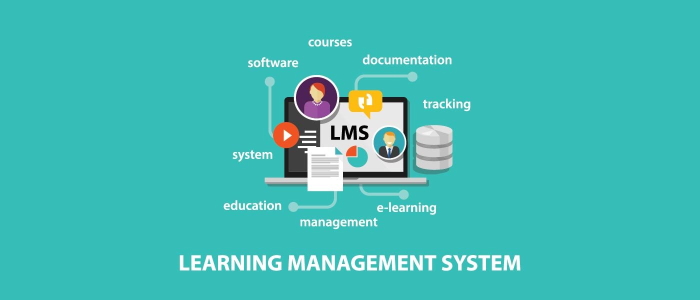The Future of E-Learning and How LMSs Fit into the Picture
E-learning has become a significant player in the education industry, with the market expected to reach $648 billion by 2030. Learning has always...
5 min read
Gary Peebles
:
Aug 24, 2023 2:30:00 PM

Most people today identify as lifelong learners. This means that they actively seek out opportunities to improve their skills, learn something new, or advance their career through skills training.
Just over 60 percent of Americans working full or part-time say that they have completed some form of continuing education or learning in the past 12 months. Most chose to do so to improve their current job skills. Around 36 percent did so to get a license or certificate needed for their job. The rest did so in hopes of getting a raise or promotion, to try to get a new job with a different employer, or because they were worried about downsizing affecting their position.
This trend isn't reserved for the U.S. Employees around the world prioritise improving their skills and expanding their knowledge throughout their careers.
No matter their reasons for continuing their education, it's clear that employees today place a value on learning opportunities. As a corporation, offering learning opportunities can help you retain employees. It can also help them to improve their skills and meet regulatory requirements.
E-learning platforms are one of the easiest ways to promote learning in the workplace. In this education guide, we dive into the basics of e-learning, and how e-learning platforms can help with corporate lifelong learning.
e-Learning, short for electronic learning, is the use of computers, smartphones, or tablets to learn a skill, complete training, or take a course.
There are a variety of different types of e-learning available.
Some involve structured courses. These may be similar to an in-person class, with a set start and end time and interaction between students and teachers, often through a video call. Or, they can include pre-recorded videos and other materials that students can complete on their own time.
Other e-learning options blend the two with a mix of real-time and student-led learning.
E-learning may be used by young students on a snow day or when they are sick and can't attend school. But it's also become a vital tool for corporations looking to promote lifelong learning or skills training among their employees.
One of the biggest benefits of utilising e-learning is that it can save corporations money by reducing the need for in-person training sessions.
Corporations can use e-learning to serve a few different purposes. Let's take a look at a few of the most popular uses.
Another big benefit of using e-learning is the chance to get employees onboarded immediately after they are hired.
Without e-learning, employees of large corporations may have to wait for the next onboarding training day. Companies with a large number of annual hires may opt to host just a few of these sessions each year. They are often costly, and time-consuming for the employees and management that run them.
With just a few onboarding sessions each year, these corporations may try to schedule their hiring around them. But if you need to hire a new employee to fill a sudden opening, this presents a challenge.
Creating an online onboarding course means employees can start at any time. A new hire can work through the onboarding materials at their own pace. They can even reference these materials at a later date if they have a question.
A virtual onboarding course also ensures that every employee receives consistent training. This is key to paving the way for the skills development that your workforce needs in order to be successful.
Employee compliance training is necessary for many fields. Occupations that pose a health or safety risk often require safety training. Individuals working in healthcare may need to sit through compliance training to meet HIPAA requirements.
Many states also require training on sexual harassment for all corporate employees, regardless of the field they work in. Your corporation may also set your own requirements for the training that your employees must complete outside of those directly related to their role with your company.
But much like with onboarding sessions, hosting these training sessions and ensuring that every new or existing employee is up-to-date can be costly and time-consuming. But e-learning education can help with this.
By creating virtual compliance training courses, you can make sure that every important topic is covered. Then, you can make these courses available to new hires and other employees to complete when they need to.
The training they receive will be consistent, which helps ensure that every employee gets the necessary information. Plus, this is a simple way to make sure that employees working in different locations or even working remotely get the training they need.
E-learning isn't just for courses to meet regulatory requirements or get new employees on board. They can also be used to improve your employees' performance.
Sales training can help make a good sales team great. It can be used to teach new skills. Or even to help your employees understand new products and offerings.
But hosting sales training courses can be a challenge. Your team may be working on very different schedules. They may meet frequently with clients at all times of the day. They may even be scattered across many different locations.
Virtual sales training e-learning courses allow your employees to improve their skills on their own time. You can even create certificates that are automatically generated once a course is completed. Use this to keep track of your employees' progress, or to reward employees who take the time to hone their skills with your courses.
One of the biggest things that employees want from their employers is the ability to continue to grow and improve their skills. When an employee is empowered to learn and advance their skillset and is rewarded to do so, they feel challenged mentally in their position. This can lead to greater satisfaction with their job.
Businesses that place a value on lifelong education for their employees are more likely to retain them as well. In the current labor shortage, this can help you keep valuable employees.
Offering a variety of e-learning courses to your employees can help you create a culture of learning in the workplace. Employees feel empowered to take control of their skills and growth. They can engage in classes that can help boost their performance, which in turn could allow them to meet sales goals or even seek promotions in the future.
For your corporation, this means the ability to promote from within. This equals more skilled and dedicated employees.
Offering e-learning courses to your employees offers several benefits. It can make hosting onboarding or compliance sessions fast, easy, and less expensive. It also gives you a chance to offer employees ongoing educational opportunities.
But where you choose to host these classes makes a big difference.
Sending out video links can quickly get confusing. Links often get lost in busy inboxes. You also have a few options for checking that employees have watched the video. This is especially an issue when it comes to compliance training.
E-learning platforms can help solve this and other issues.
These platforms create Learning Management Systems. They give you a place to host all training resources that you provide, including courses, videos, and supplemental materials. Employees get their own secure login. They can use this to track which courses they've completed, as well as to see what other courses are available.
Management can use the platform to see which employees have completed the necessary training. They can also use it to see which employees are choosing the take on additional training and classes outside of what is required.
Depending on the e-learning platform, you can even get access to tools to help you create and edit your courses. This makes it fast and easy to start creating the courses that you need.
E-learning platforms give businesses, not for profit charity associations, and other organisations the resources that they need to create and share a wide variety of types of courses.
Investing in e-learning platforms is a great way to support lifelong corporate learning. From onboarding courses to compliance training, sales training, and more, you can use an e-learning platform to offer a variety of different educational and training opportunities to your employees.
Intuto makes it easy to create and manage e-learning courses for your company. The Template Library allows you to quickly start creating your own courses covering compliance, onboarding, cyber security, and more. Add your brand logo and colors to create customized courses. You can also set up certificates that are automatically generated each time a course is completed.
Unlike other e-learning platforms, you won't pay per user. Instead, flexible plans make it easy to train as many clients, employees, and contractors as you'd like. Meet with us to learn more about how Intuto can help your organisation.

E-learning has become a significant player in the education industry, with the market expected to reach $648 billion by 2030. Learning has always...

High-quality training is essential for every level of your healthcare organisation, from healthcare providers and assistants to managers and...

Traditional means of training such as group training often take a long time. It costs a high amount of money and the learning experience might not be...